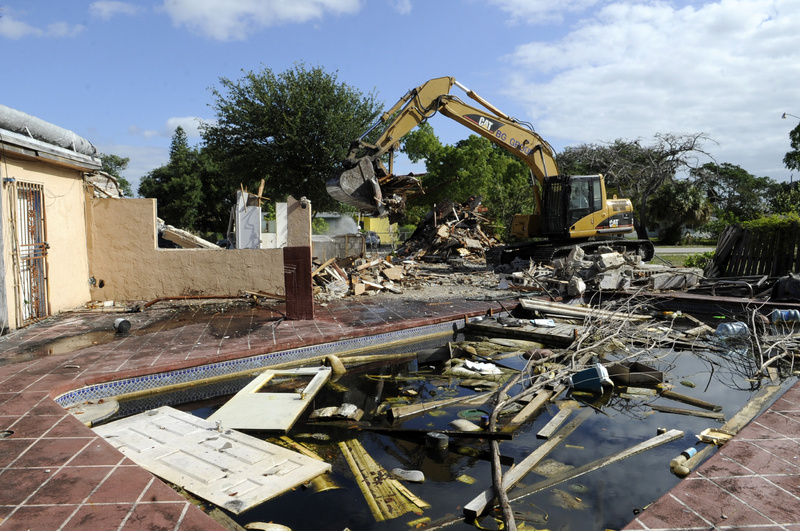FORT LAUDERDALE, Fla. – Thousands of vacant properties in South Florida’s hard-hit housing market have deteriorated into eyesores that violate health and safety laws, depress property values and spread blight. The owners of these homes: some of the world’s biggest banks.
In an extensive investigation of foreclosed homes, the Sun Sentinel found more than 10,300 property code violations lodged against banks in 10 South Florida cities since 2007.
Municipalities cited the banks because they had title to the homes. But some banks deny responsibility for neglected houses for reasons that ordinary homeowners could not, the Sun Sentinel found.
Banks shift the blame, saying maintenance isn’t their job but the responsibility of another bank or company, known as a “loan servicer.” And they delay or evade accountability simply because they are large institutions, usually based in other states, even other countries.
The Sun Sentinel, in its investigation, identified banks as owners only in cases in which they held title to the property. But the newspaper also found that years after launching foreclosure suits, some banks or their agents balk at completing the process and taking title to homes that are unlikely to sell for much. That practice fuels a separate legal “limbo” problem that traps thousands of vacated homes in years-long court cases, often as they tumble into ruin.
Banks pay little price for letting neighborhoods rot.
In South Florida, property code violations are civil matters, dealt with mostly by fines, which when left uncorrected can compound daily and grow to be ludicrously steep – as much as $4.7 million, for example, on a rundown Fort Lauderdale house owned by Germany’s Deutsche Bank.
Ultimately, banks negotiate with local officials to dramatically cut the fines so as not to hinder a home’s sale.
The results of these practices are on stark display on street after street, where vacant properties sit decaying and forlorn.
They are eyesores. Many have been looted. Some have caught fire. They attract vagrants and vandals, lead to increased crime, and can depress the value of nearby homes, particularly if there is an abundance of them in a neighborhood.
Some vacant homes pose extreme danger.
In Miramar, Fla., in October 2009, a common worry of parents came true. While his family was busy unpacking boxes and moving into the house next door, a toddler wandered into the backyard of an unoccupied, bank-owned house and drowned in the pool.
The boy’s mother, Margarette Francis, told investigators the water was so dark and thick with “garbage” it was unrecognizable as a place to swim.
“It was, oh, disgusting and I don’t think the baby knew there was a pool,” she said. “The only thing I can tell you is the slide attracted him. … He probably thought he was walking into a playground and he walked right into the … water.”
The family has filed a wrongful death lawsuit in Miami against U.S. Bank, which had title to the house, and 16 other corporate entities that had some contractual relationship or responsibility for the home after foreclosure. A spokeswoman for U.S. Bank declined comment.These days, banks are neighbors virtually everywhere, from the grand estates of Palm Beach, Fla., to the flashy new condos of downtown Miami.
As of March, banks and other mortgage lenders owned more than 19,400 properties throughout Florida’s Palm Beach, Broward and Miami-Dade counties, according to the Sun Sentinel’s analysis of tax rolls. This is up from only 2,500 a little more than five years ago.
The bank-owned homes are concentrated in predominantly minority and less well-to-do neighborhoods, where household incomes fall below the countywide medians of $48,063 in Broward, $49,879 in Palm Beach and $40,219 in Miami-Dade. They are areas where people with poor credit and insufficient income secured high-cost, highly leveraged mortgages, and left when they couldn’t meet the payments.
In Fort Lauderdale, nearly two-thirds of the code violations against bank-owned properties were in areas where most of the residents were minorities, the Sun Sentinel found. Only a quarter of all city properties are located in those neighborhoods.In a report released earlier this month, the National Fair Housing Alliance, a Washington advocacy group, charged that banks are violating the federal Fair Housing Act by neglecting the upkeep on homes in minority neighborhoods and steering real estate agents to the banks’ better-preserved homes elsewhere.
The organization has called on federal regulators and law enforcement to investigate the banks for housing discrimination practices.
Wells Fargo, one of the banks identified, denied the allegations. The bank “conducts all lending-related activities in a fair and consistent manner without regard to race; this includes maintenance and marketing standards for all foreclosed properties for which we are responsible,” said company spokeswoman Vickee Adams.
Since the real estate crash six years ago, dozens of South Florida municipalities have passed laws requiring that homes in foreclosure be registered by lenders or their agents once they become vacant. That has helped foster communication with the banks and led to quicker responses to local concerns.
“I’d say most banks want to do the right thing,” said Brian McKelligett, Fort Lauderdale code enforcement supervisor.
But banks can be bad neighbors. In the cities surveyed by the Sun Sentinel, four of 10 bank-owned properties on average were cited for violating municipal health, safety or appearance codes in 2011.
Copy the Story Link
Send questions/comments to the editors.



Success. Please wait for the page to reload. If the page does not reload within 5 seconds, please refresh the page.
Enter your email and password to access comments.
Hi, to comment on stories you must . This profile is in addition to your subscription and website login.
Already have a commenting profile? .
Invalid username/password.
Please check your email to confirm and complete your registration.
Only subscribers are eligible to post comments. Please subscribe or login first for digital access. Here’s why.
Use the form below to reset your password. When you've submitted your account email, we will send an email with a reset code.